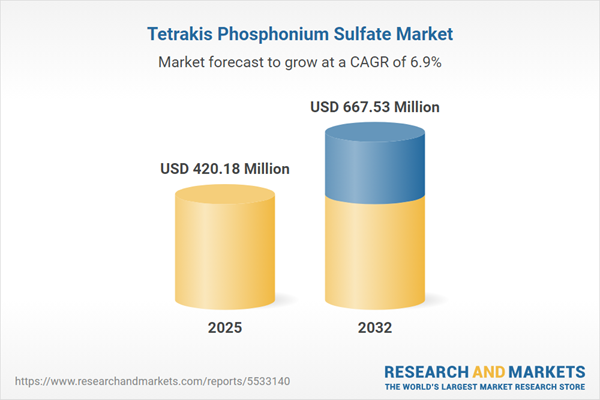Speak directly to the analyst to clarify any post sales queries you may have.
The tetrakis phosphonium sulfate market is undergoing transformation, driven by heightened industry focus on sustainable chemistry, advanced manufacturing, and evolving regulatory environments. With increased adoption across key sectors and ongoing innovation, this market offers a strategic pathway for organizations aiming to strengthen portfolio resilience and meet higher application standards.
Market Snapshot: Tetrakis Phosphonium Sulfate Industry Growth and Outlook
The tetrakis phosphonium sulfate market grew significantly from USD 392.66 million in 2024 to USD 420.18 million in 2025, reflecting robust momentum. It is projected to expand at a compound annual growth rate (CAGR) of 6.85%, reaching USD 667.53 million by 2032. This trajectory highlights sustained demand and market confidence, enabling stakeholders to anticipate emerging opportunities and manage supply chain strategies for the mid-to-long term.
Scope & Segmentation: Comprehensive Market Coverage
- Applications: Focus areas include catalysis, electroplating, pharmaceutical synthesis, and surfactants, offering versatility across chemical processes.
- End Use Industries: Automotive, chemical manufacturing, electronics (with segments in consumer electronics, semiconductors, telecommunication), and pharmaceuticals.
- Form Factors: Crystal and powder, catering to varying operational preferences and process requirements.
- Distribution Channels: Direct sales, broadline distributors, specialty distributors, and value-added distributors.
- Regional Markets: Americas (United States, Canada, Mexico, Brazil, Argentina, Chile, Colombia, Peru), Europe, Middle East & Africa (including the United Kingdom, Germany, France, Russia, Italy, Spain, Netherlands, Sweden, Poland, Switzerland, United Arab Emirates, Saudi Arabia, Qatar, Turkey, Israel, South Africa, Nigeria, Egypt, Kenya), and Asia-Pacific (China, India, Japan, Australia, South Korea, Indonesia, Thailand, Malaysia, Singapore, Taiwan).
- Key Companies: Solvay S.A., Innospec Inc., ICL Group Ltd., Buckman Laboratories International, Akzo Nobel Specialty Chemicals International, LANXESS AG, Dow Inc., BASF SE, Hubei Kesheng Biochemical Manufacturing, Guangdong Guanghua Sci-Tech.
Primary Keyword: Tetrakis Phosphonium Sulfate Market
Key Takeaways for Decision-Makers
- The compound’s unique ionic structure enables reliable performance under demanding conditions, supporting advanced catalysis, efficient electroplating, and high-purity synthesis.
- Technological advancements such as continuous processing, machine learning-driven batch optimization, and real-time monitoring are streamlining production and shortening development cycles for manufacturers.
- Stringent safety and environmental regulations have accelerated the adoption of greener synthesis pathways, driving investments in waste minimization and closed-loop recycling among producers.
- Partnerships between manufacturers, technology firms, and research institutions are catalyzing the introduction of tailored formulations and enhancing service offerings, including on-site technical support and rapid application trials.
- Flexible manufacturing and digital supply chain tools are helping market participants respond efficiently to customer demand shifts and maintain operational resilience in changing geopolitical scenarios.
Tariff Impact on Production Costs and Supply Chain Dynamics
Introduction of new United States tariffs on imported tetrakis phosphonium sulfate has led to higher landed costs for downstream processors and increased pressure on domestic and international supply chains. As a result, manufacturers are expanding capacity, refining procurement models, and exploring regional sourcing to maintain competitive positioning. These adjustments are also driving changes in pricing and the development of value-added customer services.
Methodology & Data Sources
The analysis combines rigorous secondary research—including peer-reviewed literature and technology roadmaps—with in-depth interviews from senior executives, engineers, and market experts. Quantitative data was validated through cross-referencing and expert consultation, ensuring accurate segmentation and actionable insights.
Why This Report Matters
- Delivers strategic intelligence to help guide procurement, R&D investment, and risk management in the tetrakis phosphonium sulfate market.
- Enables benchmarking against competitors and informs go-to-market strategies for entry into high-growth application and regional segments.
- Supports decision-making by clarifying the implications of technological, regulatory, and trade developments for business continuity and differentiation.
Conclusion
This market research provides a robust foundation for executives to prioritize growth, navigate new regulatory and market pressures, and align internal capabilities with external opportunities across the global tetrakis phosphonium sulfate value chain.
Additional Product Information:
- Purchase of this report includes 1 year online access with quarterly updates.
- This report can be updated on request. Please contact our Customer Experience team using the Ask a Question widget on our website.
Table of Contents
3. Executive Summary
4. Market Overview
7. Cumulative Impact of Artificial Intelligence 2025
Companies Mentioned
The companies profiled in this Tetrakis Phosphonium Sulfate market report include:- Solvay S.A.
- Innospec Inc.
- ICL Group Ltd.
- Buckman Laboratories International, Inc.
- Akzo Nobel Specialty Chemicals International B.V.
- LANXESS AG
- Dow Inc.
- BASF SE
- Hubei Kesheng Biochemical Manufacturing Co., Ltd.
- Guangdong Guanghua Sci-Tech Co., Ltd.
Table Information
| Report Attribute | Details |
|---|---|
| No. of Pages | 189 |
| Published | October 2025 |
| Forecast Period | 2025 - 2032 |
| Estimated Market Value ( USD | $ 420.18 Million |
| Forecasted Market Value ( USD | $ 667.53 Million |
| Compound Annual Growth Rate | 6.8% |
| Regions Covered | Global |
| No. of Companies Mentioned | 11 |









